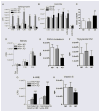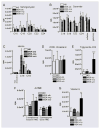Associative and predictive biomarkers of dementia in HIV-1-infected patients
- PMID: 17470750
- PMCID: PMC4431621
- DOI: 10.1212/01.wnl.0000260610.79853.47
Associative and predictive biomarkers of dementia in HIV-1-infected patients
Abstract
Background: Infection with HIV can result in a debilitating CNS disorder known as HIV dementia (HIV-D). Since the advent of highly active antiretroviral therapy (HAART), the incidence of HIV-D has declined, but the prevalence continues to increase. In this new era of HIV-D, traditional biomarkers such as CSF viral load and monocyte chemotactic protein 1 levels are less likely to be associated with dementia in patients on HAART and biomarkers that can predict HIV-D have not yet been identified.
Objective: To identify biomarkers that are associated with and can predict HIV-D.
Methods: We grouped patients with HIV based on changes in cognitive status over a 1-year period and analyzed sphingolipid, sterol, triglyceride, antioxidant, and lipid peroxidation levels in CSF.
Results: We found that increased levels of the vitamin E and triglyceride C52 predicted the onset or worsening of dementia. Elevated levels of sphingomyelin were associated with inactive dementia. Elevated levels of ceramide and the accumulation of 4-hydroxynonenals were associated with active dementia.
Conclusions: We interpret these findings to indicate that early in the pathogenesis of HIV dementia, there is an up-regulation of endogenous antioxidant defenses in brain. The failure of this attempted neuroprotective mechanism leads to the accumulation of sphingomyelin and moderate cognitive dysfunction. The breakdown of this enlarged pool of sphingomyelin to ceramide and the accumulation of highly reactive aldehydes are associated with declining cognitive function. Thus, elevations in endogenous protective mechanisms may identify patients who are at increased risk of the development of HIV dementia.
Conflict of interest statement
Figures





References
-
- McArthur JC, McDermott MP, McClernon D, et al. Attenuated central nervous system infection in advanced HIV/AIDS with combination antiretroviral therapy. Arch Neurol. 2004;61:1687–1696. - PubMed
-
- Cutler RG, Haughey NJ, Tammara A, et al. Dysregulation of sphingolipid and sterol metabolism by ApoE4 in HIV dementia. Neurology. 2004;63:626–630. - PubMed
-
- Haughey NJ, Cutler RG, Tamara A, et al. Perturbation of sphingolipid metabolism and ceramide production in HIV-dementia. Ann Neurol. 2004;55:257–267. - PubMed
-
- Sacktor N. The epidemiology of human immunodeficiency virus-associated neurological disease in the era of highly active antiretroviral therapy. J Neurovirol. 2002;8(suppl 2):115–121. - PubMed
Publication types
MeSH terms
Substances
Grants and funding
- R21 MH072534/MH/NIMH NIH HHS/United States
- R01 AG023471/AG/NIA NIH HHS/United States
- AG023471/AG/NIA NIH HHS/United States
- P30 MH075673/MH/NIMH NIH HHS/United States
- R21 AG034849/AG/NIA NIH HHS/United States
- NS49465/NS/NINDS NIH HHS/United States
- Intramural NIH HHS/United States
- MH068388/MH/NIMH NIH HHS/United States
- R01 MH077542/MH/NIMH NIH HHS/United States
- R01 AA017408/AA/NIAAA NIH HHS/United States
- MH071150/MH/NIMH NIH HHS/United States
- R01 MH071150/MH/NIMH NIH HHS/United States
- R01 NS049465/NS/NINDS NIH HHS/United States
LinkOut - more resources
Full Text Sources
Other Literature Sources
Medical
Research Materials
